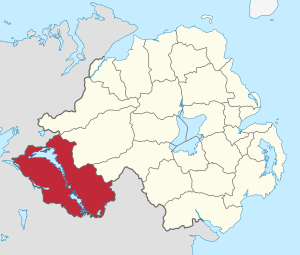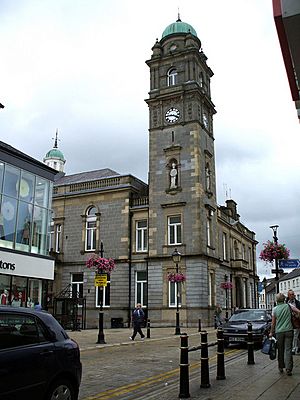Fermanagh District Council facts for kids
Quick facts for kids Fermanagh District
|
|
|---|---|
 |
|
| Area | 1,876 km2 (724 sq mi) Ranked 1st of 26 |
| District HQ | Enniskillen |
| Catholic | 59.2% |
| Protestant | 37.8% |
| Country | Northern Ireland |
| Sovereign state | United Kingdom |
| EU Parliament | Northern Ireland |
| Councillors | |
Fermanagh District Council was a local government body in Northern Ireland. It was formed from the older Fermanagh County Council. Later, in April 2015, it joined with Omagh District Council. Together, they became the new Fermanagh and Omagh District Council.
The area covered by Fermanagh District Council was much like the traditional County Fermanagh. It included all of that county. It also had a small part of County Tyrone near Dromore Road and Kilskeery Road. The main office for the council was in Enniskillen.
Contents
Council Elections and History
Fermanagh District Council had a history of close elections. People voted for councillors to represent them. These councillors made decisions for the local area.
Early Elections (1973-1981)
In 1973, the elections were very close. Ten Unionist councillors and ten Nationalist councillors were chosen. Unionists and Nationalists are groups with different ideas about Northern Ireland's future. For a while, it was unclear who would lead the council. Eventually, they found a way to work together.
In 1977, Nationalists gained more control. They had eleven councillors, while Unionists had nine. But this changed in 1981. Unionists gained a seat, making it ten Unionists and ten Nationalists again.
During this time, many smaller political parties won seats. On the Nationalist side, the Unity party did well in 1973. Later, the Irish Independence Party became a strong Nationalist group in 1981. On the Unionist side, the Democratic Unionist Party (DUP) grew stronger.

Boundary Changes (1984)
In 1984, the council's boundaries changed. This meant the way councillors were elected also changed. Before, there were five areas, each electing four councillors. New rules meant this was no longer allowed.
So, the number of electoral areas became four. These were Enniskillen, Erne East, Erne West, and Erne North. The council then had 23 councillors. They were elected every four years.
The 1985 Election
The Sinn Féin party became much more popular in the years before 1985. They won eight seats in the 1985 council elections. This gave Nationalists a thirteen to ten advantage over Unionists.
Later Elections (1989-1993)
An event in 1987, called the Cenotaph bomb, affected the Sinn Féin vote. In the 1989 elections, their number of seats was cut in half to four. The Ulster Unionist Party (UUP) gained two seats from them. This gave Unionists a small majority on the council. They kept this majority in the 1993 elections.
The 1997 Election
In 1997, Nationalists hoped to take control again. But they only gained one seat from Unionists. This left the council tied. There were eleven Unionists and eleven Nationalists. An Independent Socialist councillor, Davy Kettyles, held the deciding vote.
The 2001 and 2005 Elections
Nationalists finally took control in 2001. They won thirteen seats, while Unionists had nine. There was also one Independent councillor. In 2005, Nationalists made their lead even stronger. The Social Democratic and Labour Party (SDLP) gained a seat.
After the 2005 election, the council had:
- Nine councillors from Sinn Féin
- Five from the Ulster Unionist Party (UUP)
- Five from the Social Democratic and Labour Party (SDLP)
- Four from the Democratic Unionist Party (DUP)
The leader of the council was Councillor Stephen Huggett from Sinn Féin. The deputy leader was Councillor Cyril Brownlee from the DUP.
2011 Elections
The last election for Fermanagh District Council was in 2011. You can find more details in the 2011 Fermanagh District Council election article.
Changes to Local Government
Under a plan called the Review of Public Administration (RPA), Fermanagh District Council was set to merge. It was planned to join with Omagh District Council in 2011. This would create a larger council area. The new area would cover about 2,829 square kilometers. It would have a population of 105,479 people.
The next election was supposed to be in May 2009. However, on April 25, 2008, the Secretary of State for Northern Ireland, Shaun Woodward, announced a change. The 2009 council elections were put off. They would happen when the eleven new councils were ready in 2011.
Population Information
According to the 2011 Northern Ireland census, the area of Fermanagh District Council had 61,805 residents.

